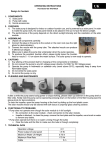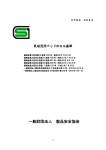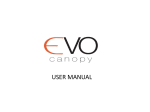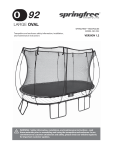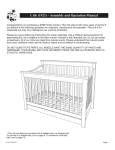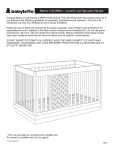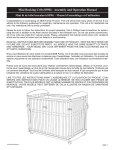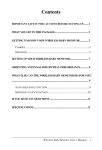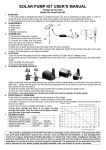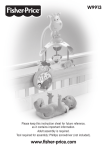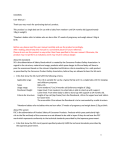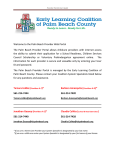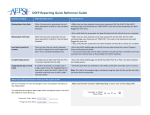Download SG Standard for Crib
Transcript
SG Standard for Crib 1. Purpose The purposes of this standard is to set requirements for the quality of safety of cribs and for the prevention of incorrect use by consumers, and to prevent damages on general consumers lives and bodies. 2. Scope of Application This standard is applied only to cribs that are primarily designed to be used at home for sleep or childcare of infants/toddlers who are 24 months old or younger (hereinafter referred to as the “Crib”), excluding oscillation-type cribs. 3. Quality of Safety The quality of safety of the Crib shall be as follows. Item Standard Checking Method 1. 1. Appearance and structure of the 1. Appearance, Crib shall be as follows: structure, and size (1) Check by eye and hand. (1) It has a smooth finish without cracks, burrs, splinters, etc. (2) (a) Each part can be assembled without causing any looseness. (b) Movable parts can be operated smoothly and without fail. (2) (a) After assembling, check by eye, etc. (b) Check by operating movable parts. (3) A mattress support has a structure which can be securely attached so that it does not easily come off when used. (3) Check by eye, hand, etc. (4) Ones with openable or sliding-type front rail must have a structure which infants/ toddlers cannot easily open or lower the front rail. (4) Check by eye and operation. (5) Ones with casters must have a feature to prevent them from moving. (5) Check by eye and operation. (6) Accessories are attached in a (6) Check by measuring using a 1 Item Standard way that abnormality does not occur when they are pulled by a force of 147.1N. Checking Method spring scale, etc. (7) There is no structure by which an infant/toddler can place his/her foot on a rung, etc., within 30cm upward from the ‘upper surface’ of a mattress support. In the case of one with a structure whose position of a mattress support is easily lowered after an infant/toddler becomes able to pull himself/herself up by holding on to something (about 5 months or older) and with an indication of such using a method that does not easily wear off, the ‘upper surface’ shall be the one after the position of a mattress support is lowered according to such indication, and the same shall apply to (9) and (12) of this section. However, these do not apply to ones which give instruction, using a method that does not easily wear off, to use by removing a mattress support after an infant/toddler becomes able to pull himself/herself up by holding on to something (about 5 months or older) (hereinafter referred to as the “Playpen Bed”). (7) Check by a scale, etc. (8) The space between a slat and another slat as well as between a slat and a post is 85mm or less. (8) Check by a scale, etc. (9) The distance between the upper surface of a mattress support and an upper rail is 60cm or (9) Check by a scale, etc. 2 Item 2. Strength Standard more (35cm or more for the Playpen Bed). Checking Method (10) The spaces between both ends of upper/lower rails of a sliding front frame and the posts of side frames are 5mm or less. (10) Check by a scale, etc. (11) In the case of one to which a net is placed on its frame, a disk with a diameter of 25mm cannot go through the mesh of the net. (11) Check by eye. (12) The shape of the upper end of a post is one that a string, etc. of an infant’s/toddler’s clothes does not get caught and which does not protrude from an upper rail exceeding 15mm. However, this does not apply to those whose distance from the upper surface of a mattress support to the upper end is 800mm or more. (12) Check by eye, hand, scale, etc. 2. Strength shall be as follows: 2. (1) There is no problem in each part when a sand bag with a mass of 10kg is dropped 250 times in a row on to the center of a mattress support from 20cm above. (1) Check by repeatedly dropping a cylindrical sandbag with a diameter of approx. 20cm at a rate of 5 times or more and 8 times or less per minute. Check by eye, hand, etc. for any problem in each part. (2) There is no problem in each part when a force of 294.2N is applied to the center of the upper rails of the front frame, end frame, and side frames. (2) Check by eye, hand, etc. after applying the force using a weight, etc. (3) There is no problem (e.g. a slat comes off) when the center of the slat is pulled with a force of (3) Check by a spring scale, etc. 3 Item 147.1N. Standard Checking Method (4) There is no problem in each part when the center of the upper rails of the front frame, end frame, and side frames are pulled with a force of 196.1N. (4) Check by a spring scale, etc. (5) There is no problem in each part when a force of 588.4N is applied continuously for 10 minutes to the center of the front edge of a mattress support. (5) Use two cylindrical sandbags with a diameter of approx. 30cm and a mass of 30kg, and check by eye, hand, etc. after removing the sandbags. (6) In the case of one to which a net or board is placed on its frame, there is no problem (e.g. breakage, etc. of the net or board) when a force of 196.1N is applied to the center of the net or board. (6) Check by eye, hand, etc. after pulling or pushing the net or board using a disk with a diameter of approx. 10cm. (7) There is no problem in each part and the displacement of the center of side frame’s upper rail is 30mm or less when a force of 294.2N is alternately applied 30 times on the outer side of the center of side frames’ upper rails. (7) Measure by a scale, etc. and check by eye, hand, etc. if there is any problem. (8) There is no problem in each part when an impact is applied to the inner side of the center of the upper rails of the front frame, end frame, and side frame using a sandbag with a mass of 10kg. (8) Hang a cylindrical sandbag with a diameter of approx. 20cm at the end of a 1m pendulum, move it 50cm in a horizontal direction, and then apply impact by releasing it without adding any force. Check by eye, hand, etc. after applying the impact. (9) Among the surfaces enclosed by a front frame, end frame, and side frames, those within a height of 15cm from the upper surface of a mattress support (9) Check by eye, hand, scale, etc. 4 Item 3. Material Standard have a solid structure. Checking Method 3. Materials of the Crib shall be as follows: 3. (1) Products that are made of synthetic resin as well as parts painted with synthetic resin paint are not harmful to infants/toddlers. (1) They shall conform to the provision on toys set forth in Article 4 of the Public Notice No.370 of 1959 of the Ministry of Health and Welfare based on the Food Sanitation Act. Check it based on the test result document. (2) Ones which use a fiber product, such as cloth, for their frames are not harmful to infants/toddlers. (2) Check by the testing method specified by the section on formaldehyde in Appendix 1 of Article 1 of the Ordinance No.34 of 1974 of the Ministry of Health and Welfare based on the Act on Control of Household Products Containing Harmful Substances (for infants/toddlers who are 24 months old or younger). Check it based on the test result document. 4. Indications and User’s Manual Indications on and a user’s manual of the Crib shall be as follows. Item 1. Indications Standard 1. Indicate the following information on a product using means that do not easily wear off. However, except for (2), information shall be indicated where easily viewable on the outside surface of a front frame or side frames. 5 Checking Method 1. Check the following by eye, hand, etc. that the indications do not easily wear off, the indications do not easily come off, and whether or not necessary information is indicated. Item Standard (1) A registered business name or its abbreviation (limited to an abbreviated name or symbol approved by the Minister of Economy, Trade and Industry, or a trademark registered with the Minister) under the Consumer Product Safety Act (No.31 of June 6, 1973). Checking Method (2) The year and month of manufacture or importation or their abbreviation. (3) Instruction that the Crib is intended to be used by infants/toddlers who are 24 months old or younger. (4) Instruction that users should be careful that a string, etc. of an infant’s/toddler’s clothes do not get caught by the posts. (4) However, those with posts which do not protrude from the upper rails of a front frame, end frame, and side frames do not require indication of this information. (5) Instruction that users should check that fastening hardware and screws are securely attached. (6) Instruction that users should use a mattress or Japanese style mattress, etc. with no gaps between the surfaces enclosed by a front frame, end frame, and side frames. (7) In the case of one with an openable or sliding front frame, Pictogram 1 and instruction that the front frame must be fixed at a specified position after use. 6 (7) & (8) For Pictograms 1 and 2, use blue frame, white background, and black font. Also, the background of an exclamation mark must be yellow, arrows must be red, and other pictures must be blue. Item Standard Baby could fall Raise the front frame Checking Method The pictograms must be arranged in a way easily recognizable by users. Other than the yellow background of the exclamation mark, any other colors that are easily recognizable by users may be used for the indication of the pictograms. Pictogram 1 (8) In the case of one whose position of a mattress support can be adjusted, Pictogram 2 and instruction that it must be used by setting the mattress support at the lowest position when it is used for sleeping or childcare of an infant/toddler who has become able to pull himself/herself up by holding on to something (about 5 months or older). After becoming able to つかまり立ちした後 pull himself/herself up (about (概ね 5mon. or older) ) Baby could fall Lower the mattress support Pictogram 2 (9) Instruction not to put anything in the Crib that can be a step for an infant/toddler after he/she becomes able to pull himself/herself up by holding on to something (about 5 months or older). (10) Instruction to make sure that, 7 (8) However, ones with instruction which is indicated where easily viewable by a mean that does not easily wear off, to use without a mattress support after an infant/toddler becomes able to pull himself/herself up by holding on to something do not require Pictogram 2 and the instruction. Item 2. User’s Manual Standard when using a mattress or Japanese style mattress, etc., they have appropriate heights so that an infant/toddler does not easily climbs over the frame and fall from the Crib. 2. Attach a user’s manual to a product that clearly indicates the following information. Also on the product, clearly indicate (a), (b), and (c) of 2-(3) Precautions. It is recommended that they are clearly indicated by using pictograms so that general consumers can easily understand. However, (1) may be omitted for those which indicate (2), (3), (4), and (5) using a means that does not easily wear off. (1) Instruction to read the user’s manual and to keep it after reading. (2) In the case of a ready-to-assemble type, guide and precautions for assembling. (3) Precautions (a) The Crib is intended to be used by an infant/toddler who is 24 months old or younger, and the Playpen Bed must be used without a mattress support after an infant/toddler becomes able to pull himself/herself up by holding on to something (about 5 months or older). (b) In the case of the Crib with adjustable mattress support height, instruction to adjust the 8 Checking Method 2. Check that it does not use technical terms and it is easily comprehensible for general consumers. Item Standard Checking Method distance from the upper surface of a mattress support to an upper rail to be 60cm or more after an infant/toddler becomes able to pull himself/herself up by holding on to something (about 5 months old or older). (c) In the case of an openable or sliding type, instruction to fix a front frame at a specified position after using. (d) In the case of one with casters that are equipped with a device to prevent casters from moving, instruction to fix the casters while using. (e) Japanese style mattress, etc. that are used must be ones which do not create gaps between frames and themselves and which have appropriate firmness. (f) Instruction not to place anything both inside and outside the Crib that an infant/toddler may step on. (g) Instruction to place the product on a flat, horizontal surface and not to use it near any dangerous objects, such as a heater. (h) Instruction not to attach any dangerous objects, such as strings. (i) Instruction not to sit on, hang on to, or shake the frame. 9 Item Standard Checking Method (j) Instruction not to use the product when it has problems, such as damages and/or defects. (k) Instruction that the product must not be used by two or more persons at the same time. (l) If an infant’s/toddler’s head width is narrower than the space between a slat and another slat as well as between a slat and a post, instruction to use the product with adequate attention. (4) Statement that the SG Mark system is a compensation system for bodily injury caused by defects of the Crib. Additionally, statement that only the Crib is subject to the compensation system, and mattresses, Japanese style mattresses, etc. used with the Crib are not eligible for the system. (5) Name, address, and phone number of a manufacturer, importer, or distributor. 10










